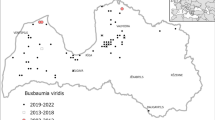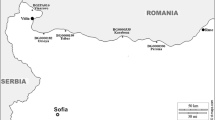Abstract
The complexity of nature conservation raises questions about biodiversity protection at the level of species as well as their spatial distribution between differently designated nature conservation areas. We have concentrated on comparison of the existing protected areas and recently established conservation initiative areas—Important Plant Areas. We have estimated how well these areas support the protection of two plant groups—bryophytes and vascular plants. We sought answers to the following questions: (a) are there any trends in the distribution of protected bryophyte and vascular plant species in the protected areas network, and (b) does the Important Plant Areas network promote better protection of bryophyte species compared with the existing protected areas network. Our results demonstrated that bryophytes need special care in nature conservation decisions to reach the reasonable conservation target. Important Plant Areas that were targeted to vascular plants have less importance in preserving bryophyte diversity than already existing conservation areas system. Conservation programs like IBA, IPA etc. have their specific tool and outcome to add conservation values to the existing protected areas system.



Similar content being viewed by others
References
Anderson S (2002) Identifying important plant areas. Plantlife International, Salisbury, UK
Araújo MB (2004) Matching species with reserves—uncertainties from using data at different resolutions. Biol Conserv 118:533–538
Araújo MB, Lobo JM, Moreno JC (2007) The effectiveness of Iberian areas in conserving terrestrial biodiversity. Conserv Biol 21:1423–1432
Brodie J, John DM, Tittley I, Holmes MJ, Williamson DB (2007) Important plant areas for algae. A provisional review of sites and areas of importance for algae in the United Kingdom. Plantlife International, Salisbury, UK
Brooks TM, da Fonseca GAB, Rodriques ASL (2004) Protected areas and species. Conserv Biol 18:616–618
Castroviejo S (2005) Taxonomy, floras and conservation. In: Leadlay ESJ (ed) Taxonomy and plant conservation. Cambridge University Press, Cambridge
Chiarucci A, D’Auria F, Bonini I (2007) Is vascular plant species diversity a predictor of bryophytes species diversity in Mediterranean forests? Biodivers Conserv 16:525–545
Colwell RK (2005) EstimateS: statistical estimation of species richness and shared species from samples. Version 7.5. User’s guide and application published at http://purl.oclc.org.estimates. Cited 24 Apr 2009
Colwell RK, Mao CX, Chang J (2004) Interpolation, extrapolation, and comparing incidence-based species accumulation curves. Ecology 85:2717–2727
Deguise IE, Kerr JT (2006) Protected areas and prospects for endangered species conservation in Canada. Conserv Biol 20:48–55
Dove ADM, Cribb TH (2006) Species accumulation curves and their applications in parasite ecology. Trends Parasitol 22:568–574
Dunning JB, Groom MJ, Pulliam HR (2006) Species and landscape approaches to conservation. In: Groom MJ, Meffe GK, Carroll CR (eds) Principles of conservation biology, 3rd edn. Sinauer Associates, Sunderland, Massachusetts, pp 419–465
EELIS (2008) Estonian Nature Information System—Environmental Register: Estonian Environment Information Centre. http://eelis.ic.envir.ee/w4/. Cited 24 Apr 2009
EU Habitats Directive (2004) (92/43/EEC) (1992) Consolidated text. Office for Official Publication of The European Union. CONSLEG: 1992LOO43-01.05
Fleishman E, Murphy D, Brussard P (2000) A new method for selection of umbrella species for nature conservation planning. Ecol Appl 10:569–579
Geissler P (1995) First experience with conservation of southern European bryophyte sites. Cryptogam Helv 18:51–155
Gotelli NJ, Colwell RK (2001) Quantifying biodiversity: procedures and pitfalls in the measurement and comparison of species richness. Ecol Lett 4:379–391
Hallingbäck T (2007) Working with Swedish cryptogam conservation. Biol Conserv 35:334–340
Hess GR, Bartel RA, Leidner AK, Rosenfeld KM, Rubino MJ, Snider SB, Ricketts TH (2006) Effectiveness of biodiversity indicators varies with extent, grain, and region. Biol Conserv 132:448–457
Hopkinson P, Evans J, Gregory RD (2000) National-scale conservation assessments at and appropriate resolution. Divers Distrib 6:195–204
Ingerpuu N, Vellak K (2000) Bryologically important sites in Estonia. Lindbergia 25:106–111
Ingerpuu N, Vellak K, Kukk T, Pärtel M (2001) Bryophyte and vascular plant species richness in boreo-nemoral moist forests and mires. Biodivers Conserv 10:2153–2166
Ingerpuu N, Vellak K, Liira J, Pärtel M (2003) Relationships between species richness patterns in deciduous forests at the north Estonian limestone escarpment. J Veg Sci 14:773–780
Kindt R, Van Damme P, Simons AJ (2006) Patterns of species richness at varying scales in western Kenya: planning for agroecosystem diversification. Biodivers Conserv 15:3235–3249
Kukk T (1999) Eesti taimestik. Vascular plant flora of Estonia. Teaduste Akadeemia Kirjastus, Tartu-Tallinn
Külvik M, Palo A, Kukk Ü, Kull T, Vellak K, Roosaluste E, Jüriado I, Parmasto E, Saar I, Hurt E (2005) IPAs in Estonia. In: Anderson S, Kušik T, Radford S (eds) Important plant areas in central and eastern Europe. Plantlife International, Salisbury, UK, pp 43–47
Laguna E, Deltoro VI, Pérez-Botella J, Pérez-Rovira P, Serra LI, Olivares A, Fabregat C (2004) The role of small reserves in plant conservation in a region of high diversity in eastern Spain. Biol Conserv 119:421–426
Lilleleht V (1998) Eesti punane raamat. Red data book of Estonia. Eesti Teaduste Akadeemia Looduskaitsekomisjon, Tartu
Lõhmus A, Lõhmus P, Vellak K (2007) Substratum diversity explains landscape-scale co-variation in the species richness of bryophytes and lichens. Biol Conserv 35:405–414
Looduskaitseseadus (2004) Looduskaitseseadus. 17.06.2004 (RT I 2004, 53, 373) 18.07.2004
Lund MP (2002) Performance of the species listed in the European Community ‘Habitats’ Directive as indicators of species richness in Denmark. Environ Sci Policy 5:105–112
Maiorano L, Falcucci A, Garton EO, Boitani L (2007) Contribution of the Natura 2000 Network to Biodiversity conservation in Italy. Conserv Biol 21:1433–1444
Margules CR, Sarkar S (2007) Systematic conservation planning. Cambridge University Press, Cambridge
Martinez I, Carreño F, Escudero A, Rubio A (2006) Are threatened lichen species well-protected in Spain? Effectiveness of a protected areas network. Biol Conserv 133:500–511
McKinney ML (2002) Effects of national conservation spending and amount of protected areas on species threat rates. Conserv Biol 16:539–543
Meffe GK, Carrol CR (1994) The species in conservation. In: Meffe GK, Carrol CR (eds) Principles of conservation biology. Sinauer Associates. Inc. Publishers, Sunderland, Massachusetts, pp 50–77
Melo AS, Bini LM, Thomaz SM (2007) Assessment of methods to estimate aquatic macrophyte species richness in extrapolated sample size. Aquat Bot 86:377–384
O’Dea N, Araújo MB, Whittaker R (2006) How well do important bird areas represent species and minimize conservation conflict in the tropical Andes? Divers Distrib 12:205–214
Oldfield TEE, Smith RJ, Harrop SR, Leader-Williams N (2009) A gap analysis of terrestrial protected areas in England and its implications for conservation policy. Biol Conserv 120:303–309
Papp P (2008) Selection of important bryophyte areas in Hungary. Folia Cryptogam Est 44:101–111
Pärtel M, Kalamees R, Reier Ü, Tuvi E-L, Roosaluste E, Vellak A, Zobel M (2005) Grouping and prioritization of vascular plant species for conservation: combining natural rarity and management need. Biol Conserv 123:271–278
Pharo EJ, Beattie AJ, Binns D (1999) Vascular plant diversity as a surrogate for bryophyte and lichen diversity. Conserv Biol 13:282–292
Pharo EJ, Beattie AJ, Pressey RL (2000) Effectiveness of using vascular plants to select reserves for bryophytes and lichens. Biol Conserv 96:371–378
Possingham HP, Andelman SJ, Vynne CH (2006) Protected areas: goals, limitations, and design. In: Groom MJ, Meffe GK, Carroll CR (eds) Principles of conservation biology, 3rd edn. Sinauer Associates. Inc. Publishers, Sunderland, Massachusetts, pp 509–551
Prendergast JR, Quinn RM, Eversham BC, Gibbons DW (1993) Rare species, the coincidence of diversity hotspots and conservation strategies. Nature 365:335–337
Riigi Teataja (2004) I ja II kaitsekategooria kaitse alla võetavate liikide loetelu. VV, RTI 21.05.2004, 44, 313
Riigi Teataja (2007) Kaitsealuste samblaliikide püsielupaikade kaitse all võtmine ja kaitse-eeskiri. RTL, 12.06.2007, 47,830
Roberge JM, Angelstam P (2004) Usefulness of the umbrella species concept as a conservation tool. Conserv Biol 18:76–85
Rodrigues ASL, Gaston KJ (2001) How large do reserve networks need to be? Ecol Lett 4:602–609
Rodrigues ASL, Andelman SJ, Bakarr MI, Boitani L, Brooks TM, Cowling RM, Fishpool LDC, da Fonseca GAB, Gaston KJ, Hoffmann M, Long JS, Marquet PA, Pilgrim JD, Pressey RL, Schipper J, Sechrest W, Stuart SN, Underhill LG, Waller RW, Watts MEJ, Yan X (2004) Effectiveness of the global protected area network in representing species diversity. Nature 428:640–643
Sabovljevic M, Ganeva A, Tsakiri E, Ştefănuţ S (2001) Bryology and bryophyte protection in south-eastern Europe. Biol Conserv 101:73–84
Sauberer N, Zulka K-P, Abensperg-Traun M, Berg H-M, Bieringer G, Milasowszky N, Moser D, Plutza C, Pollheimer M, Storch C, Tröstl R, Zechmeister HG, Grabherr G (2004) Surrogate taxa for biodiversity in agricultural landscapes of eastern Austria. Biol Conserv 117:181–190
Secretariat of the Convention on Biological Diversity (2002) Global strategy for plant conservation. Secretariat of the Convention on Biological Diversity, Quebec
Sepp K, Palang H, Mander Ü, Kaasik A (1999) Prospects for nature and landscape protection in Estonia. Landsc Urban Plan 46:161–167
Sergio C, Figueira R, Draper D, Menezes R, Sousa AJ (2007) Modelling bryophyte distribution based on ecological information for extent of occurrence assessment. Biol Conserv 135:341–351
Söderström L (1981) Distribution of bryophytes in spruce forests on hill slopes in central Sweden. Wahlenbergia 7:141–153
Stewart NF (2004) Important stoneworts areas: and assessment of the best areas for stoneworts in the United Kingdom (summary). Plantlife International, Salisbury, UK
Stewart RR, Ball IR, Possingham HP (2007) The effect of incremental reserve design and changing reservation goals on the long-term efficiency of reserve systems. Conserv Biol 21:346–354
Vanderpoorten A, Engels P, Sotiaux A (2005) A GIS-based survey for the conservation of bryophytes at the landscape scale. Biol Conserv 121:189–194
Vellak K (2007) New EU Habitats Directive species for Estonia. J Bryol 29:137–138
Vellak A, Tuvi E-L, Reier Ü, Kalamees R, Roosaluste E, Zobel M, Pärtel M (2009a) Past and present effectiveness of protected areas for conservation of naturally and anthropogenically rare plant species. Conserv Biol 23:750–757
Vellak K, Ingerpuu N, Kannukene L, Leis M (2009b) New Estonian records and amendments. Liverworts and mosses. Folia Cryptogam Est 45:91–93
Waples RS, Adams PB, Bohnsack J, Taylor B (2008) A biological framework for evaluating whether a species is threatened or endangered in a significant portion of its range. Conserv Biol 21:964–969
Warman LD, Forsyth DM, Sinclair ARE, Freemark K, Moore HD, Barret TW, Pressey RL, White D (2004) Species distributions, surrogacy, and important conservation regions in Canada. Ecol Lett 7:374–379
Wiersma YF, Urban DL (2005) Beta diversity and nature reserve system design in the Yukon, Canada. Conserv Biol 19:1262–1272
Zechmeister HG, Moser D (2001) The influence of agricultural land-use intensity on bryophyte species richness. Biodivers Conserv 10:1609–1625
Acknowledgments
We would like to thank Ene Hurt for her help obtaining data for IPAs. The study was supported by the European Union through the European Regional Development Fund (FIBIR Center of Excellence), by targeted financing (SF0180095s08, SF0180012s09) and by grant 7910 of the Estonian Science Foundation.
Author information
Authors and Affiliations
Corresponding author
Rights and permissions
About this article
Cite this article
Vellak, K., Ingerpuu, N., Vellak, A. et al. Vascular plant and bryophytes species representation in the protected areas network on the national scale. Biodivers Conserv 19, 1353–1364 (2010). https://doi.org/10.1007/s10531-009-9766-4
Received:
Accepted:
Published:
Issue Date:
DOI: https://doi.org/10.1007/s10531-009-9766-4




